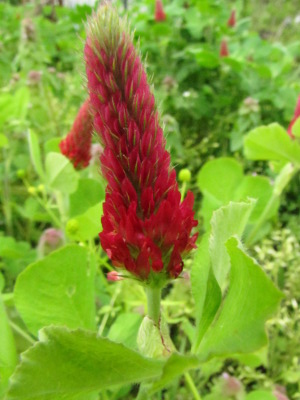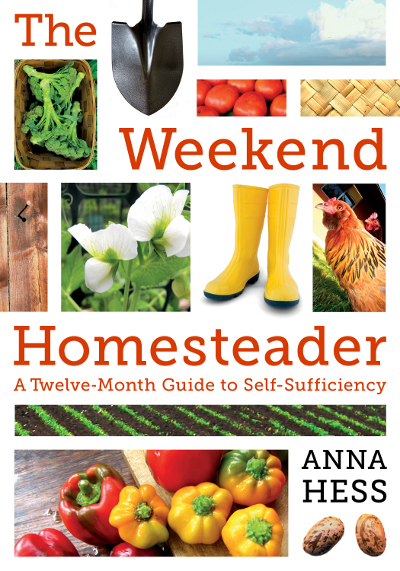
Beginning a holistic orchard
The first chapter of
Phillips' The Holistic Orchard introduces the author's
philosophy of creating a healthy ecosystem holistically rather than
fighting to mask the symptoms with allopathic treatments (such as using
organic, but still harmful, sprays). His goal, he writes is "not
so much to destroy problems as to create health."
So, how do you start an
orchard so healthy it can be maintained with simple mulching and foliar
sprays of fish oil? First, you need to realize that fruit trees
and berry bushes thrive in a forest edge habitat, where the soil is
dominated by fungi
over bacteria at a ratio of roughly 10:1.
 To get there, Phillips first
tills, then plants a cover crop of red or crimson clover. These two species
have an affinity for mycorrhizal fungi, which will stand the trees in
good stead a year later when they finally grace the soil.
To get there, Phillips first
tills, then plants a cover crop of red or crimson clover. These two species
have an affinity for mycorrhizal fungi, which will stand the trees in
good stead a year later when they finally grace the soil.
Phillips' cover crops go
into the ground in the fall, and they grow for a solid year before
being scythed and allowed to rot on the soil surface over the second
winter. Organic matter added to the earth from the top down is a
great way to promote beneficial soil fungi, so you definitely don't
want to till the clovers in.
Since clover is
perennial, you'll either need to fork out the roots come spring number
two, or lay down a kill mulch (cardboard topped by wood chips) the
autumn before. Either way, Phillips recommends preparing a circle
of vegetatation-free soil about four to six feet in diameter for each
future fruit tree.
Once the trees are in
place, mulch is key. Phillips swears by ramial wood chips, which
come from deciduous twigs and branches less than 2.5 inches in
diameter, meaning that the C:N ratio is quite low (30:1). For
those of us who can't be as discerning, I think it's nearly as good to
just let any kind of deciduous wood chips rot for a couple of years
before using.
 Haphazard
mulching is handy to
keeping the diversity of soil life high, so Phillips lays down heavy
mulches on only one side of the tree each year, using spoiled hay and
straw in spots around producing trees for even more diversity.
Right up against the trunk, a three to four inch deep layer of pea
stone extending a foot or so out from the tree in all directions keeps
the young trees dry.
Haphazard
mulching is handy to
keeping the diversity of soil life high, so Phillips lays down heavy
mulches on only one side of the tree each year, using spoiled hay and
straw in spots around producing trees for even more diversity.
Right up against the trunk, a three to four inch deep layer of pea
stone extending a foot or so out from the tree in all directions keeps
the young trees dry.
I'm ashamed to say that
I've never been able to think a year or two in advance to fully prepare
the soil for perennials using cover crops, but this first chapter of The
Holistic Orchard
has inspired me to try prepping areas I want to house perennials in
2014. I think I'll tweak Phillips' technique a bit, though, since
I'm working on a backyard scale rather than running a commercial
orchard --- kill mulches always trump tilling in my book. But
since I'm starting in the fall, that means I won't be able to plant
until the spring, so I'll probably run back
to back buckwheat cover crops, then either put in my perennials in
fall of 2013 or plant clover then to give the soil another year of
fertility building.
 I'm curious to hear from
others. How have you prepped the soil for fruit trees, and did
your technique bear fruit? Are you a believer in simply replacing
chemical sprays with organic alternatives that do the same thing, or do
you try to garden holistically?
I'm curious to hear from
others. How have you prepped the soil for fruit trees, and did
your technique bear fruit? Are you a believer in simply replacing
chemical sprays with organic alternatives that do the same thing, or do
you try to garden holistically?
We'll be discussing
chapter two next Wednesday, and I have to admit I've read ahead and
find that section equally inspiring. I hope you'll join the book
club and read along!
Want more in-depth information? Browse through our books.
Or explore more posts by date or by subject.
About us: Anna Hess and Mark Hamilton spent over a decade living self-sufficiently in the mountains of Virginia before moving north to start over from scratch in the foothills of Ohio. They've experimented with permaculture, no-till gardening, trailersteading, home-based microbusinesses and much more, writing about their adventures in both blogs and books.
Want to be notified when new comments are posted on this page? Click on the RSS button after you add a comment to subscribe to the comment feed, or simply check the box beside "email replies to me" while writing your comment.

Is the clover for an entire field, or just individual spots where new trees will go?
I'm new to fruit trees myself, but I'd forget the cover crop and just plant as soon as possible. For fertility, you can always mulch with compost and seed clover outside of that area. Phillips' method might be best, but I'd rather not lose all that growing time and have to deal with killing the clover before the trees are even in the ground.
BeninMA --- He generally seeds entire fields, or at least that's what it sounds like in his book. It does seem like a lot of work, but I suspect it might be worth it. A lot of old orchard books recommend running cover crops for a year or two before planting, but I can't seem to find any controlled experiments online with data about the effects.
I've actually got a very small side by side comparison going since our new gully kill mulch is right next door to our new Celeste fig and will have figs in it in a year or two. Maybe then I'll be able to tell you whether cover crops improved the soil enough to make up for losing that time to mature the trees.
So far I am really into what the author is saying, except for the spray schedule he has. Even if what he sprays is natural, organic, holistic or whatever, there's no way I'm going to be able to do more than maybe one spray a year. I would much rather take the approach of getting them into good soil in the first place like he describes. I'm really enjoying learning about the soil.
I'm also bummed that the wood chips he wants are hardwoods, because most of what we cut and chip are pines. I'm using them anyway on trees and such, maybe I'll regret that....
I've never spent a year prepping for trees, but I have tried it for garlic. I did not have a side-by-side comparison, but I was not impressed enough at the time to do it a 2nd time. Now though, I am going back and leaving one of those original beds fallow for next year while I build the soil. Three years later, it's still a clay pit.
De --- I'm with you on the sprays. I'm actually not entirely sold on his sprays being harmless, either. Of course, he has to have at least some pristine apples to sell, so I'm hopeful that we an keep our apples healthy enough without sprays to meet our far less stringent criteria.
I'm not sure that softwood chips will actively hurt. Maybe they'll be more acidic? I'll be curious to hear what you think of them after a few years.
Interesting to hear about your garlic bed prepping experiment. I don't think that letting land lie fallow does much good, but actively pushing cover crops can build up a lot of organic matter fast. (That assumes your soil is good enough that the cover crops will grow, of course.) This year, I've seen huge differences in the beds that went through three rounds of buckwheat over the course of the summer. Of course, that's definite work --- once a month, you need to cut and reseed.
Since I've read this book any of the sticks or limbs that blow out of the large trees in our back yard I break up into 6" or smaller pieces and throw them around our fruit trees. It's a much easier task than having a stick pile and having to spend a day chipping them. Anything that is too big to break I am going to try hugelkultur on one or two of our raised vegetable beds.
As far as prepping before planting the most I've done was dug the hole 4-5 months before the trees were to ship and mixed in the amendments and compost.
One thing I am quickly learning though is to plant your trees high because all this mulch will break down into great soil and eventually raise the level of the ground around the trunk and could cause other problems.